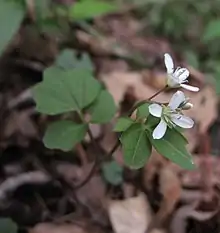Cardamine flagellifera
Cardamine flagellifera, commonly known as Blue Ridge bittercress,[2] is a species of herbaceous plant in the mustard family. It is native to eastern North America, where it is found primarily in the southern Blue Ridge.[2][3] It is a perennial that produces white flowers in the spring.[4]
| Cardamine flagellifera | |
|---|---|
 | |
| Scientific classification | |
| Kingdom: | Plantae |
| Clade: | Tracheophytes |
| Clade: | Angiosperms |
| Clade: | Eudicots |
| Clade: | Rosids |
| Order: | Brassicales |
| Family: | Brassicaceae |
| Genus: | Cardamine |
| Species: | C. flagellifera |
| Binomial name | |
| Cardamine flagellifera | |
Its natural habitat is moist cove forests and bottomlands, along streambanks and in seepage areas.[2] Unlike the similar-looking Cardamine clematis which grows in high elevations, C. flagellifera is typically found in low to moderate elevations.[2]
This species is considered to be vulnerable due to its limited distribution, and its habitat requirement of forests with an undistributed herbaceous layer.[1]
Taxonomy
Two varieties are sometimes recognized. These are:[2]
- C. flagellifera var. flagellifera - Large-flowered Blue Ridge bittercress; widespread in the southern Appalachian Mountains.
- C. flagellifera var. hugeri - Small-flowered Blue Ridge bittercress; has a more restricted range.
References
- "Cardamine flagellifera". NatureServe Explorer. NatureServe. Retrieved 2017-12-21.
- Alan Weakley (2015). "Flora of the Southern and Mid-Atlantic States".
- "Cardamine flagellifera". County-level distribution map from the North American Plant Atlas (NAPA). Biota of North America Program (BONAP). 2014. Retrieved 7 December 2017.
- "Cardamine flagellifera in Flora of North America @ efloras.org". efloras.org. Retrieved 7 December 2017.
This article is issued from Wikipedia. The text is licensed under Creative Commons - Attribution - Sharealike. Additional terms may apply for the media files.
